텅스텐 카바이드 절삭 공구 현대 기계 가공에 필수적입니다. 놀라운 경도와 강도로 유명한 이 공구는 다음과 같은 모든 용도로 사용됩니다. 항공우주 부품 자동차 구성요소.
하지만 실제로 어떻게 작동할까요? 무엇이 이토록 신뢰할 수 있는 재료이며, 다른 공구 소재보다 왜 선택되는 걸까요?
이 블로그에서는 텅스텐 카바이드 공구가 어떻게 만들어지는지, 절삭 성능은 어떤지, 그리고 공구를 더 오래 사용할 수 있도록 하는 요소는 무엇인지 자세히 알아보겠습니다.
기계 공장을 운영하든 산업 생산을 관리하든 이러한 도구의 작동 방식을 이해하면 더 나은 구매 및 운영 결정을 내리는 데 도움이 될 수 있습니다.
텅스텐 카바이드란 무엇인가?
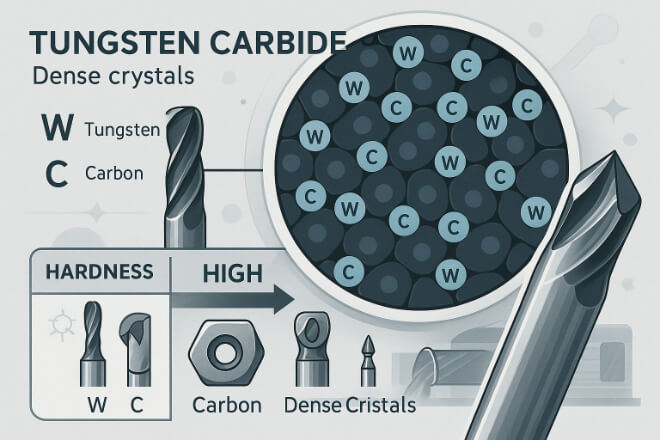
텅스텐 카바이드는 텅스텐(W)과 탄소(C)로 구성된 화합물입니다. 이 두 가지가 융합되면 다이아몬드만큼 단단한 물질이 형성됩니다.
하지만 다이아몬드와 달리 텅스텐 카바이드는 뛰어난 인성을 가지고 있습니다. 따라서 단단한 금속을 쉽게 깨지거나 깨지지 않고 절단하는 데 적합합니다.
도구에 사용되는 대부분의 텅스텐 카바이드는 결합제(보통 코발트)와 혼합되어 카바이드 입자를 함께 고정하고 압력 하에서 강도를 높이는 데 도움이 됩니다.
주요 속성:
텅스텐 카바이드 절삭 공구의 제작 방법
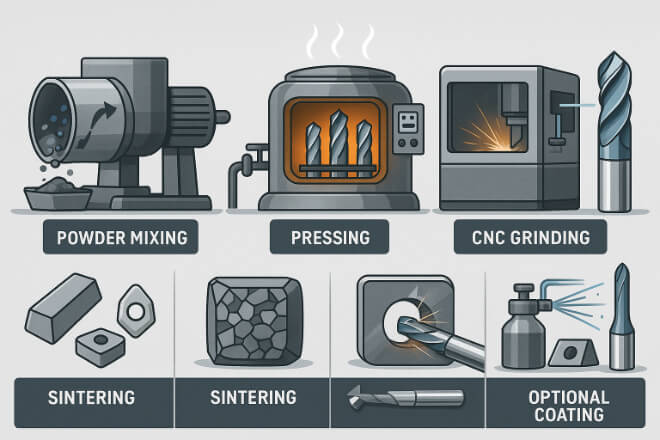
텅스텐 카바이드 공구의 제조 공정에는 몇 가지 주요 단계가 포함됩니다.
분말 제조: 미세한 텅스텐과 탄소 분말을 혼합한 다음, 코발트와 혼합합니다.
압축: 분말을 원하는 도구(또는 블랭크) 모양으로 압축합니다.
소결: 프레스된 부품을 약 1400~1500°C로 가열합니다. 이 과정에서 입자들이 서로 결합되어 조밀하고 강한 구조가 형성됩니다.
연삭 및 마무리: 공구는 정확한 모양과 허용 오차에 맞게 연삭됩니다.
코팅(선택 사항): 일부 도구에는 내열성을 개선하고 마찰을 줄이기 위해 TiAlN이나 DLC와 같은 코팅이 적용됩니다.
이 과정을 통해 고속과 극한의 하중에서도 작동할 수 있는 절삭 공구가 탄생합니다.
텅스텐 카바이드 공구가 절단에서 작동하는 방식
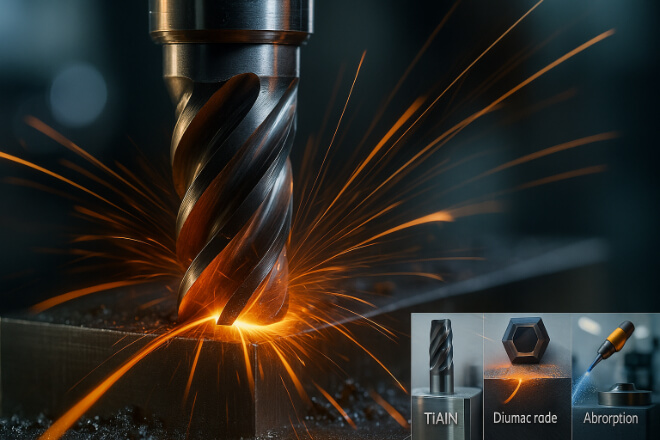
텅스텐 카바이드 공구는 소재를 가공물에서 전단하여 절삭합니다. 공구가 회전(드릴, 엔드밀 등)하거나 선형 이동(인서트 또는 선삭 공구)할 때, 소재는 칩 형태로 제거됩니다.
초경 공구가 효과적인 이유는 무엇입니까?
경도: 경화강과 초합금을 절단할 수 있습니다.
내열성: 높은 절단 속도에서도 우수한 성능을 발휘합니다.
날의 안정성: HSS나 세라믹 공구보다 날카로움을 더 오래 유지합니다.
내마모성: 공구 교체 빈도와 가동 중지 시간이 줄어듭니다.
고속 또는 고강도 절삭 작업에서 카바이드 공구는 마모, 열 연화, 소성 변형에 저항하면서 안정성을 유지합니다.
텅스텐 카바이드 절삭 공구의 종류
카바이드는 작업에 따라 다양한 형태로 사용됩니다.
| 도구 유형 | 일반적인 사용 |
|---|---|
| 카바이드 인서트 | 선삭, 밀링 및 홈 가공 |
| 엔드밀 | 금속 및 복합재 밀링 |
| 드릴 | 고속 및 심공 드릴링 |
| 리머 | 구멍의 정밀 마무리 |
| 버 | 디버링 및 가벼운 물질 제거 |
| 탭 및 스레드 밀 | 견고한 합금 및 강철의 나사산 가공 |
이러한 도구는 표준 형상으로 제공되거나 특정 작업에 맞게 맞춤 설계될 수 있습니다.
성능에 있어서 코팅의 역할
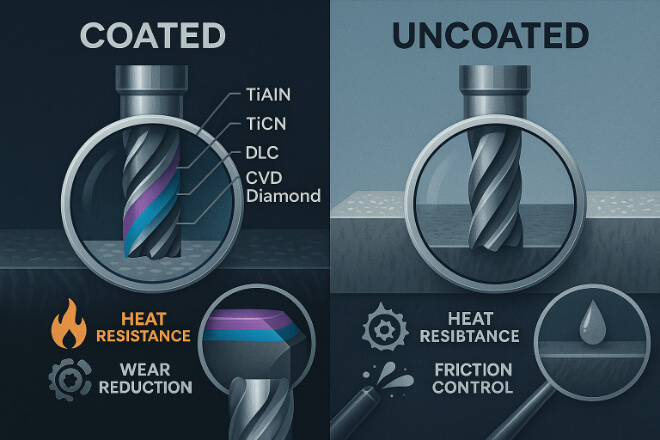
베어 텅스텐 카바이드도 우수한 성능을 보이지만, 코팅을 적용하면 한 단계 더 발전할 수 있습니다. 널리 사용되는 코팅은 다음과 같습니다.
TiAlN(티타늄 알루미늄 질화물): 내열성이 우수함.
TiCN(탄소질화티타늄): 양호 내마모성.
DLC(다이아몬드 유사 탄소): 마찰을 줄여 알루미늄과 연성 금속에 이상적입니다.
CVD 다이아몬드: 탄소 섬유나 세라믹과 같은 연마재를 절단하는 데 사용됩니다.
코팅은 다음과 같은 데 도움이 됩니다.
공구 수명 연장
열 축적을 줄이세요
더 빠른 절단 속도를 허용합니다
표면 마감 개선
절삭 공구 성능에 영향을 미치는 요소
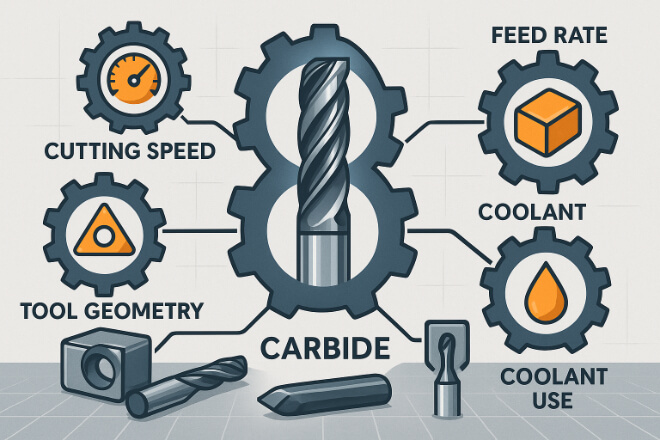
텅스텐 카바이드 공구는 견고하지만 성능은 여러 요인에 따라 달라집니다.
절단 속도: 속도가 빨라질수록 더 나은 코팅과 내열성이 필요합니다.
이송 속도: 공구 압력과 열 생성에 영향을 미칩니다.
절단되는 재료: 경화강, 합금 또는 알루미늄은 모두 다르게 반응합니다.
냉각수 사용: 온도를 낮추고 칩을 씻어내는 데 도움이 됩니다.
공구 형상: 공구가 재료에 어떻게 결합되는지에 영향을 미칩니다.
이러한 요소를 최적화하면 도구 수명을 늘리고, 가동 중지 시간을 줄이고, 생산 비용을 낮출 수 있습니다.
마모 및 공구 고장의 일반적인 징후
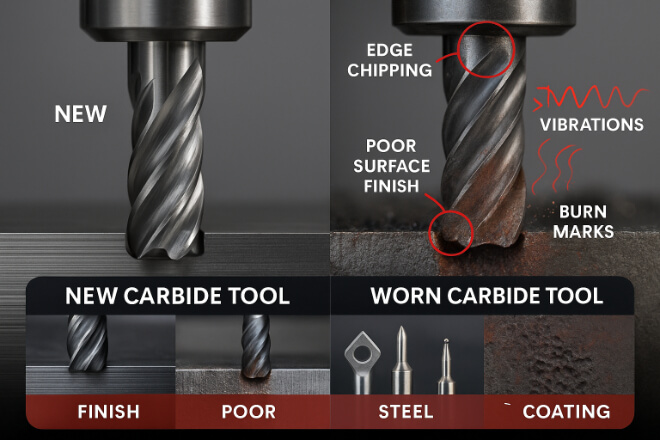
공구를 언제 교체하거나 재연마해야 하는지 아는 것이 중요합니다. 다음 사항에 유의하세요.
둔화되거나 깨진 절단면
작업물의 표면 마감이 좋지 않음
예상치 못한 도구 파손
기계 진동이나 소음 증가
화상 자국이나 변색
수명이 다한 도구를 사용하면 부품과 기계 모두 더 큰 손상을 입을 수 있습니다.
도구 유지 관리 및 보관 팁
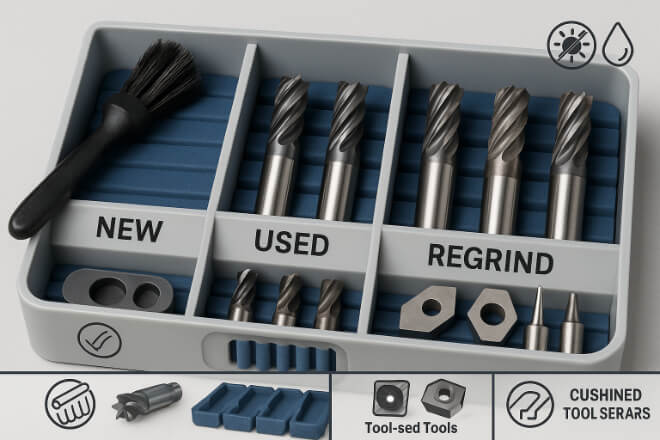
텅스텐 카바이드 절삭 공구를 최대한 활용하려면 다음 팁을 따르세요.
사용 후 도구를 깨끗이 닦으세요
건조하고 쿠션이 있는 용기에 보관하세요.
도구의 모서리 손상을 방지하려면 도구를 분리해 두십시오.
코발트 용출을 방지하려면 습한 환경을 피하십시오.
사용 상태(신품, 중고품, 재분쇄용)에 따라 도구에 라벨을 붙입니다.
적절한 유지관리 = 도구 수명 연장 + 가공 결과 향상.
오래 지속되는 도구의 환경적 이점
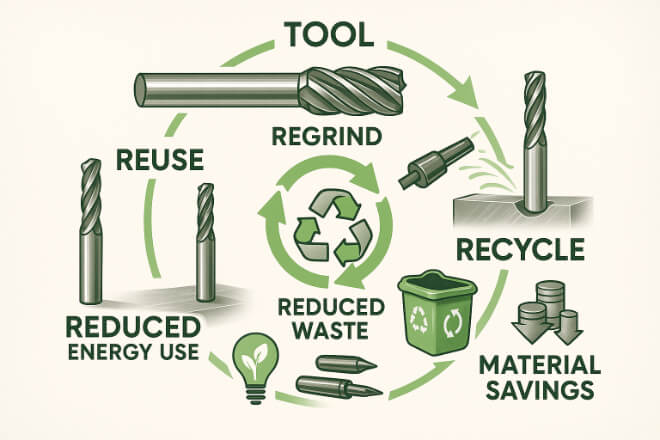
텅스텐 카바이드 공구를 사용하면 지속가능성 목표 달성에도 도움이 될 수 있습니다. 방법은 다음과 같습니다.
교체 횟수 감소 = 제조 폐기물 감소
재분쇄 옵션은 수명을 연장하고 자원 사용을 줄입니다.
중고 카바이드 공구에 대한 재활용 프로그램이 있습니다.
더 효율적인 절단 = 부품당 에너지 사용량 감소
결론
텅스텐 카바이드 절삭 공구는 경도, 정밀성, 내구성이 스마트하게 조화를 이루어 작동합니다.
제작 방법부터 절단 방법까지 모든 세부 사항이 혹독한 환경에서도 최대 성능을 발휘하도록 설계되었습니다.
올바른 속도, 코팅, 유지관리를 통해 올바르게 사용하면 다른 절삭 재료보다 훨씬 뛰어난 성능을 발휘할 수 있습니다.
그렇기 때문에 기계 가공 및 제조 분야의 의사 결정권자들은 생산 수요에 앞서 나가기 위해 초경 공구를 선택합니다.
일관된 결과를 제공하는 안정적인 도구를 찾고 계신가요? 확인해 보세요. 레톱즈 귀하의 작업장이나 생산 현장에 적합한 텅스텐 카바이드 솔루션을 찾아보세요.
